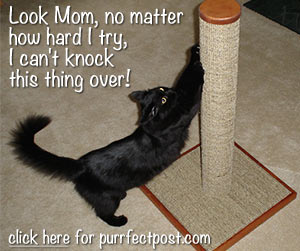Training Your Cat To Stay Off The Kitchen Counter
Cats jumping on counters. It's one of the things many cat owners dislike and why some people don't have cats. Many people believe that there's no way to keep cats off counters and tables. But that isn't really true. Cats can be trained to stay off your counters.
Why Do Cats Like to Jump on Counters?
There are a few reasons why cats like to jump onto counters. They include:
- Cats like high places. Even a moderately high-up surface such as a counter gives cats some feeling of safety and lets them survey their territory.
- Cats like to look out windows.Many times, counter-tops provide cats with access to windows.
- Cats are curious. “What’s on the counter?” “What’s up there?” "What are you doing?"
Why Do Cats Like to Jump on Kitchen Counters Specifically?
OK, so you can see that being high up in general is appealing to cats, but why is it so common for them to like to spend time on kitchen counters in particular?
- Their noses lead them there.There are often interesting smells emanating from there.
- Their humans spend a lot of time working there. Cats want to be close to their human companions when the humans are in the kitchen.
These are the most common reasons; some less common ones are discussed further down.
Reasons You Might Not Want Your Kitty on the Counter
Though it might seem like less trouble and fairly harmless just to allow your cat to be on the kitchen counter, there are important reasons to put a stop to the behavior, including:
- You don’t want fur (or worse) in your food (at least, not more than you may get already).
- There may be dangerous things for your cat on or adjacent to the counter, such as poisonous foods, knives, and the hot stove.
Seek a Win-Win Solution
Think of your strategy for keeping your cat off the counter this way:
- Make the counter less attractive to your cat.
- Make alternative places more appealing, if not irresistable, to your cat.
To borrow cat expert and author Pam Johnson-Bennett’s terms, combine deterrence with positive redirection. Don’t just say “no” to your kitty; also give her an option to which she’ll gladly say “yes.” With this approach, both of you will be satisfied.
Positive Alternatives to the Counter for Your Cat
Let’s focus on the positive part of the strategy first—making sure that your kitty has options besides the kitchen counter that meet her need to be on elevated surfaces and her desire to spend time with her human family members when they’re in the kitchen.
- If you’re about to welcome a cat into your home, you want to be proactive and set up an environment that respects both your new cat’s needs and your house rules.
- Cats will appreciate these steps even if there are no problems; they’re preventive as well as part of a fix.
Cats live in three dimensions.
Unlike cats, humans aren't always jumping and climbing; usually our feet are on or near the ground. Appropriate some of the under-used vertical space in your shared abode—the area from about from three feet high to the ceiling—for your kitty’s need to be elevated (physically, that is; she’s already worshipped).
You can create makeshift perches and ledges on the cheap:
- Put a throw blankets on the back of a couch near a window.
- Clear some space on window sills.
- Clear some space on tables that are located near windows or in corners from which your kitty can keep tabs on household activity.
Keep in mind that your cat is going to lobby—perhaps persistently—to use this “prime real estate” anyway. Cats are strongly motivated to reach higher-than-ground-level spots, especially ones with a view, and they get frustrated—and usually act out their frustrations—if that core need is not met.
Specially Designed Cat Furniture May Have Many Benefits and Can Be a Long-Term Bargain
A multi-level cat tree is custom-made to satisfy a cat's need to reach higher ground and hang out there. A well-built one, with a wide sturdy base, lasts many years and typically provides scratching, playing, snoozing, and perching opportunities. Buy a cat tree with perching shelves that are big enough to allow your kitty to sprawl and take a snooze. Many cats like a low-sided wall around their perching platforms, for a feeling of extra snugness and confidence that they won't fall off.
A cat tree is your kitty’s own space, and it often becomes one of her favorite places in which to spend time.
Mutually Acceptable Ways that Your Kitty Can Keep You Company When You’re in the Kitchen
OK, you’ve got cat trees and other elevated platforms throughout the house, and they all have perfect views for cats – and your cat uses them. But being sociable and curious, she wants to be with you when you’re in the kitchen. For these occasions, provide your kitty with spots other than the counter in which she feels close to you.
- Designate a sturdy footstool or chair in the kitchen for your kitty. That way, she’s right there but not sampling the dinner you’re preparing.
- Depending on the layout of your home, you may be able to position a cat tree or favorite feline sitting spot outside the kitchen but close by, where you and your kitty can maintain eye contact.
- If you play with your cat and feed her just prior to preparing meals, she may settle in for a nap while you’re busy in the kitchen. If she has a comfy snoozing area not far from the kitchen, your chance of success with this positive redirection increases.
Deterrents for Cats That Climb on Counters
In addition to supplying your kitty with appealing alternatives to the counter, make the counter a distinctly un-fun place to be from her viewpoint. Another Pam Johnson-Bennett concept is the "Least Invasive, Minimal Aversive" or LIMA approach. In short, when it comes to deterrents, use the gentlest solution that works. With that in mind, here are deterrent measures listed in approximate order of increasing invasiveness.
- Start with the basics. Cover leftover food and clean food off plates in the sink. Occasionally, doing this alone solves the problem.
- As soon as you see kitty jump on the counter, clap your hands to get her attention, and say “No!” in your moderately loud, stern but loving “bad kitty” voice. Then, if at all practical, pick up your out-of-bounds cat and gently move her to a more suitable spot. Be consistent with this response. One obvious downside to this deterrent is that you have to be present when your kitty commits the misdemeanor.
- The X-Mat is covered with raised bumps that kitty will find very irritating. Place one or more these on the counter surface, and most likely, your cat will be dissuaded from jumping on the counter.
- Sticky Paws is basically double-sided tape. Place this at strategic locations on the counter surface. Your cat will avoid the area because she doesn’t like her paws sticking to the tape.
- Ssscat is an innovative product that uses a motion detector and blasts a short, harmless, painless spray onto a cat (or anything else) that sets off the motion detection system. Choose a location and spray angle of the Ssscat product so that it only sprays “offenders.”
- The “pennies in a can” technique is tried-and-true. Put about 15 coins each in a few empty soda cans. Put tape over the cans so the coins can’t fall out. Place the cans so that they’re precariously teetering over the edge of the counter. When your cat jumps onto the counter, the cans will fall off, making a loud noise, and probably causing your cat to hurriedly jump off the counter and scurry off.
Tips on Using Deterrents
When it comes to using deterrents for cats, there are some things to remember.
- Don’t rely solely on deterrence to correct problem behaviors in your cat. Deterrent measures should work in conjunction with environmental enhancements and other positive redirection approaches. It’s essential that your cat have ample outlets for her core behavioral needs.
- Deterrents work on most cats. However, some cats will find ways around them or learn to live with them. You may have to try multiple deterrents and/or change the way they’re applied.
- Usually, once your cat has altered her behavior as per your desire, you can remove “in place” deterrents such as Sticky Paws or coin-filled cans. But you may need to re-apply the techniques if the problem re-occurs.
- If you’re trying to change the habits of one cat in a multi-pet household (or in a household with toddlers), some deterrents may not be advisable—you don’t want to startle innocent bystanders. In particular, the coins-in-cans technique is probably not a good idea in these circumstances.
- Some deterrent measures are ill-advised for cats that have had traumatic experiences or are profoundly skittish. You don’t want to overly frighten anyone and cause other stress-related inappropriate behaviors.
- Discuss deterrents with your veterinarian first, especially if your cat is geriatric or has any health problems.
- Never employ any deterrent that could physically harm your cat or leave her with emotional scars. The goal with deterrents to keep her off the counter is simply to make her think, "This is no fun being here. I'd much rather be over there on the cat tree.”
General Tips for Cats That Jump on Kitchen Counters
- Don't expect instant results if the behavior pattern has become ingrained into your cat’s daily lifestyle. Habits often take time to break. Be patient and understanding, trying to see things from your cat's point of view.
- Make sure your positive redirection efforts are acceptable to your cat. If she ignores the spot you've set up, think about how you can improve its "cat appeal." Perhaps change the location, put a bird feeder outside the window (filled with bird food, of course, and far enough from the window so the birds can dine in peace), or upgrade the wobbly old cat tree you bought when you knew less about cats and cat furniture.
Special Cases
Scenario: Your cat is using the counter as a safe getaway. If your kitty is being chased by a dog or a child, she may seek the counter as place to escape the harassment.
Solution: Provide adequate vertical escape routes (as well as horizontal ones, such as an interior cat door that leads to a safe room) for your cat, and don’t leave your cat with a child or dog who chases her in the same room without responsible human supervision.
Scenario: Your cat goes up on the counter because there aren’t enough (desirable) elevated spaces in a multi-cat household.
Solution: Provide more than enough prime perching (and scratching!) spots, at multiple levels, throughout your home, to support the various preferences of the cats.
Scenario: Your cat only jumps onto the counter when there's food on it and goes right to the food as if she's ravenous. This could be a sign of hyperthyroidism or other health problem.
Solution: Consult with your veterinarian about any suspicious or markedly changed behavior in your cat.
You May Also Like These Articles:
Can You Make Your Cat into a Lap Cat?
How to Train Your Cat to Walk on a Leash
Cat Not Using Litter Box? Inappropriate Urination in Cats
"Love Bites" or Softening You up to Eat?
Why Some Cats Do Not Like Doors
Notice: Ask-a-Vet is an affiliated service for those who wish to speak with a veterinary professional about their pet's specific condition. Initially, a bot will ask questions to determine the general nature of your concern. Then, you will be transferred to a human. There is a charge for the service if you choose to connect to a veterinarian. Ask-a-Vet is not manned by the staff or owners of CatHealth.com, and the advice given should not delay or replace a visit to your veterinarian.






